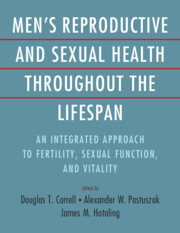 Men's Reproductive and Sexual Health Throughout the Lifespan
Men's Reproductive and Sexual Health Throughout the Lifespan from Section 4 - Laboratory Evaluation and Treatment of Male Infertility
Published online by Cambridge University Press: 06 December 2023
The prevalence of azoospermia in the general population is 1% and azoospermic men constitute approximately 10–15% of all infertile men. While the advent of microTESE substantially improved sperm recovery compared to standard biopsy or other techniques, the procedure remains inefficient, costly, and very time consuming, both in retrieval and separation/sorting. Three conventional sperm sorting techniques are commonly used in andrology clinics: density gradient centrifugation, sperm washing, and swim-up, all of which have provided reliable solutions to isolate normal sperm from highly concentrated semen samples. The field of microfluidics is the most rapidly developing field for sperm selection related to the field of ART. It is particularly powerful when considering applications in single-cell or low-cell number analyses. Magnetically activated cell sorting and fluorescence-activated cell sorting are alternative and promising technologies. Further research is needed to optimally identify and isolate sperm to help couples achieve the goal of biologic children.
To save this book to your Kindle, first ensure [email protected] is added to your Approved Personal Document E-mail List under your Personal Document Settings on the Manage Your Content and Devices page of your Amazon account. Then enter the ‘name’ part of your Kindle email address below. Find out more about saving to your Kindle.
Note you can select to save to either the @free.kindle.com or @kindle.com variations. ‘@free.kindle.com’ emails are free but can only be saved to your device when it is connected to wi-fi. ‘@kindle.com’ emails can be delivered even when you are not connected to wi-fi, but note that service fees apply.
Find out more about the Kindle Personal Document Service.
To save content items to your account, please confirm that you agree to abide by our usage policies. If this is the first time you use this feature, you will be asked to authorise Cambridge Core to connect with your account. Find out more about saving content to Dropbox.
To save content items to your account, please confirm that you agree to abide by our usage policies. If this is the first time you use this feature, you will be asked to authorise Cambridge Core to connect with your account. Find out more about saving content to Google Drive.